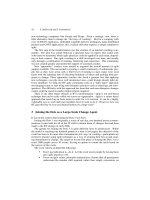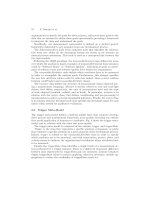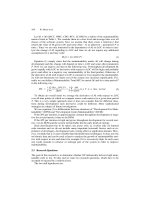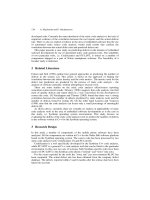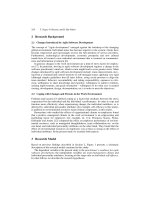Wiley understanding bitcoin cryptography engineering and economics nov 2014
Bạn đang xem bản rút gọn của tài liệu. Xem và tải ngay bản đầy đủ của tài liệu tại đây (5.16 MB, 291 trang )
Understanding
Bitcoin
Cryptography, engineering, and economics
PEDRO FRANCO
This edition first published 2015
© 2015 Pedro Franco
Registered office
John Wiley & Sons Ltd, The Atrium, Southern Gate, Chichester, West Sussex, PO19 8SQ, United
Kingdom
For details of our global editorial offices, for customer services and for information about how to
apply for permission to reuse the copyright material in this book please see our website at www.
wiley.com.
All rights reserved. No part of this publication may be reproduced, stored in a retrieval system,
or transmitted, in any form or by any means, electronic, mechanical, photocopying, recording or
otherwise, except as permitted by the UK Copyright, Designs and Patents Act 1988, without the
prior permission of the publisher.
Wiley publishes in a variety of print and electronic formats and by print-on-demand. Some
material included with standard print versions of this book may not be included in e-books or in
print-on-demand. If this book refers to media such as a CD or DVD that is not included in the
version you purchased, you may download this material at . For
more information about Wiley products, visit www.wiley.com.
Designations used by companies to distinguish their products are often claimed as trademarks.
All brand names and product names used in this book are trade names, service marks, trademarks or registered trademarks of their respective owners. Neither the publisher nor the author
are associated with any product or vendor mentioned in this book. The material contained in
this book is not related to any work the author has performed for any present or past employer.
Opinions expressed in the book are solely those of the author and do not express the views of the
author’s current or past employers.
Limit of Liability/Disclaimer of Warranty: While the publisher and author have used their best
efforts in preparing this book, they make no representations or warranties with respect to the
accuracy or completeness of the contents of this book and specifically disclaim any implied warranties of merchantability or fitness for a particular purpose. It is sold on the understanding that
neither the publisher nor the author are engaged in rendering professional services and neither
the publisher nor the author shall be liable for damages arising herefrom. If professional advice
or other expert assistance is required, the services of a competent professional should be sought.
A catalog record for this book is available from the Library of Congress.
A catalogue record for this book is available from the British Library.
ISBN 9781119019169 (hardback/paperback) ISBN 9781119019145 (ebk)
ISBN 9781119019152 (ebk)
ISBN 9781119019138 (ebk)
Cover design: Wiley
Cover image: © Shutterstock/Lightboxx
Set in 10 pt Times New Roman by Sparks – www.sparkspublishing.com
Printed in Great Britain by TJ International Ltd, Padstow, Cornwall, UK
Dedicated to Alvaro, Rafael, Luis, and Nayra
Contents
About the Author
xi
Acknowledgments
xiii
Foreword
xv
Prologue
xvii
Preface
xix
PART ONE: INTRODUCTION AND ECONOMICS
1
CHAPTER 1
Foundations
3
1.1
1.2
1.3
1.4
4
6
8
9
Decentralized
Open Source
Public Asset Ledger
It’s Not Only the Currency, It’s the Technology
CHAPTER 2
Technology (Introduction)
2.1
2.2
2.3
2.4
2.5
Centralized Database
Addresses, Transactions
Distributed Database, the Blockchain
Wallets
The Different Meanings of Bitcoin
CHAPTER 3
Economics
3.1
3.2
Medium of Exchange
3.1.1 Pros
3.1.2 Cons
Store of Value
11
11
13
15
17
18
21
22
25
26
27
v
vi
Contents
3.3
3.4
3.5
3.6
3.7
3.2.1 Bitcoin as Investment
3.2.2 Pros
3.2.3 Cons
Unit of Account
Deflation
Volatility
Effect on the Financial Industry and Monetary Policy
Regulation
CHAPTER 4
Business Applications
4.1
4.2
4.3
4.4
4.5
4.6
4.7
Money Transfer
Exchanges
Payment Processors
Web Wallets
Multisignature Escrow Services
Mining
ATMs
29
30
31
32
32
33
35
37
39
39
40
43
43
45
46
48
PART TWO: BITCOIN TECHNOLOGY
49
CHAPTER 5
Public Key Cryptography
51
5.1
5.2
5.3
5.4
5.5
5.6
Public Key Encryption
Digital Signatures
RSA
Elliptic Curve Cryptography
5.4.1 Elliptic Curve Summary
5.4.2 Elliptic Curve Theory
Other Cryptographic Primitives
5.5.1 Blind Signatures
5.5.2 Shamir Secret Sharing
Bitcoin Addresses
53
56
59
62
63
64
71
71
72
73
CHAPTER 6
Transactions
77
6.1
6.2
6.3
6.4
6.5
6.6
6.7
80
82
84
85
86
89
92
Transaction Scripts
Pay-to-address and Pay-to-public-key Transactions
Multisignature (m-of-n) Transactions
Other Transaction Types
Transaction Signature
Pay-to-script-hash (P2SH)
Standard Transactions
vii
Contents
CHAPTER 7
The Blockchain
7.1
7.2
7.3
7.4
7.5
7.6
7.7
Hash Functions
Time-stamp
Proof-of-work
The Blockchain
Double-spend and Other Attacks
7.5.1 Race Attack
7.5.2 Finney Attack
7.5.3 Transaction Spamming
Merkle Trees
7.6.1 Transaction Malleability
Scalability
CHAPTER 8
Wallets
8.1
8.2
8.3
8.4
8.5
8.6
8.7
8.8
8.9
95
99
101
105
113
115
116
116
117
119
120
123
Symmetric-key Cryptography
Offline Wallets
8.2.1 External Storage Media
8.2.2 Paper Wallets
8.2.3 Offline Devices
8.2.4 Hardware Wallets
Web Wallets
Brain Wallets
Deterministic Wallets
8.5.1 Message Authentication Code (MAC)
8.5.2 Hierarchical Deterministic Wallets
Multisignature Wallets
Vanity addresses
Simplified Payment Verification (SPV)
The “Payment Protocol” (BIP 70)
CHAPTER 9
Mining
9.1
9.2
9.3
9.4
95
125
126
127
127
129
130
131
132
132
134
135
136
137
139
141
143
Mining Technology
Pooled Mining
Transaction Fees
Selfish Mining
146
149
154
156
PART THREE: THE CRYPTOCURRENCIES LANDSCAPE
159
CHAPTER 10
The Origins Of Bitcoin
161
10.1 David Chaum’s Ecash
162
viii
Contents
10.2
10.3
10.4
10.5
10.6
Adam Back’s Hashcash
Nick Szabo’s bit gold and Wei Dai’s b-money
Sander and Ta-Shma’s Auditable, Anonymous Electronic Cash
Hal Finney’s RPOW
Satoshi Nakamoto
CHAPTER 11
Alt(ernative) Coins
11.1
11.2
11.3
11.4
11.5
11.6
11.7
11.8
11.9
Litecoin
PeerCoin
Namecoin
Auroracoin
Primecoin
Dogecoin
Freicoin
Other Alt-coins
The Case For/Against Alt-coins
CHAPTER 12
Contracts (the Internet of Money or Cryptocurrencies 2.0)
12.1
12.2
12.3
12.4
12.5
Digital Assets
Smart Property
Micropayments
Autonomous Agents
Other Applications
12.5.1 Crowd-funding
12.5.2 External State Contract
12.5.3 Contract for Differences
12.5.4 Distributed Exchange
12.5.5 Deposits
12.5.6 Saving Addresses
12.6 Inserting Data into the Blockchain
12.7 Meta-coins
12.7.1 Colored Coins
12.7.2 Counterparty
12.7.3 Ethereum
12.7.4 Mastercoin
12.7.5 Nxt
12.7.6 Ripple
CHAPTER 13
The Privacy Battle
13.1 Network Analysis
13.2 Laundry Services
163
164
165
167
168
171
172
173
174
175
175
176
177
177
178
183
183
185
186
187
189
189
190
190
191
191
192
192
194
196
197
199
202
203
204
209
209
212
Contents
13.3 Greenlisting
13.4 Privacy-enhancing Technologies
13.4.1 CoinJoin
13.4.2 CoinSwap
13.4.3 Stealth Addresses
13.4.4 Merge Avoidance
13.4.5 Committed Transactions
13.5 Fully Anonymous Decentralized Currencies
13.5.1 Zero-knowledge Proofs
13.5.2 Zero-knowledge Proof of Graph 3-colorability
13.5.3 Zero-knowledge Proof for the Discrete Logarithm
13.5.4 Non-interactive Zero-knowledge Proofs
13.5.5 Accumulators
13.5.6 Zerocoin
13.5.7 Zerocash
CHAPTER 14
Odds and Ends
14.1 Other Transaction Protocols
14.1.1 Micropayment Channels
14.1.2 Atomic Cross-chain Trading
14.2 Alternatives to Proof-of-work
14.2.1 Proof-of-stake
14.2.2 Proof-of-burn
14.3 Merged Mining
14.4 Side-chains
14.5 Open Transactions
14.6 Quantum Computing
14.7 Recent Advances in Cryptography
14.7.1 Homomorphic Encryption
14.7.2 Obfuscation
ix
213
214
214
215
217
219
220
221
221
221
223
224
225
226
228
231
231
231
232
233
234
236
237
238
240
242
244
244
245
Bibliography
247
Index
259
About the Author
edro Franco was born in Astorga, Leon (Spain). He holds a MSc in Electrical Engineering from ICAI, a BSc in Economics, and an MBA from INSEAD. Pedro has been
a consultant with McKinsey and Boston Consulting Group and a researcher with IIT
prior to gaining more than 10 years of experience in financial markets holding Quant
and Trading positions in Credit, Counterparty Risk, Inflation, and Interest Rates. He
has created various mathematical libraries for financial derivatives, and managed teams
of software developers.
The author can be contacted at
P
xi
Acknowledgments
hanks to Juan Ramirez for helping me gather the courage to write this book.
Thanks to Jon Beracoechea, Manuel Castro, and Robert Smith for exhaustively
reviewing an early version of the book and providing many excellent suggestions. Thanks
also to Eli Ben-Sasson, Alejandro and Alvaro Franco, Jeff Lim, Jan Pelzl, Stefan Thomas, Evan Schwartz, Rodrigo Serrano, Alena Vranova, and Bob Way for reviewing parts
of the book and providing insightful comments.
Finally, thanks to my family for their patience and support; without them this book
could not have been written.
T
xiii
Foreword
have been hoping for some time for a good book covering the technology and ideas
behind Bitcoin to be written.
There is certainly a wealth of information about cryptocurrencies, but the field advances rapidly and it is sometimes difficult for the non-initiated to understand the fundamentals and catch up with new developments. This book takes readers to a thorough
understanding of the current state-of-the-art cryptocurrencies’ technology, as well as its
future economic and technological implications, without assuming any previous knowledge of the many fields than constitute Bitcoin. This is an enabling book that empowers
the reader to participate in and contribute to this great adventure.
The book clearly exposes many concepts previously mainly known to insiders of
the cryptocurrencies’ world. It covers a wide range of topics, from the economics or the
basic technology (such as elliptic curve cryptography, Merkle trees or the blockchain)
to advanced cryptographic concepts (such as non-interactive zero-knowledge proofs),
and explores many applications based on these ideas (such as multi-signature wallets
or fully anonymous payment systems). All this is accomplished in a book that is very
approachable and comprehensible.
Readers new to Bitcoin will surely be surprised by the ingenuity of the technology
and the broad range of applications it enables. Those familiar with Bitcoin will find many
sections, such as the sections on economics or advanced applications of cryptocurrencies,
informative and thought provoking.
I believe Pedro’s book will be well received in the business and financial community
as well as by the general public, spreading the knowledge about Bitcoin and contributing
to this technology crossing the chasm to the early majority.
Jeff Garzik
Bitcoin Core Developer at BitPay, Inc.
I
xv
Prologue
–
–
–
–
–
–
–
–
–
–
–
–
–
–
–
–
–
–
–
–
–
–
–
–
–
What is Bitcoin?
It’s a digital currency.
Yeah, I get that, but who is behind Bitcoin?
Nobody.
What do you mean by nobody? Somebody must be controlling it!
Nobody is controlling it, it is an algorithm.
What? You mean like Terminator? So you say the world is going to be taken over by
machines?
Well, not the world, but maybe some businesses.
Right... (rolling her eyes) But who controls the algorithm? Some mad scientist?
It’s an open source project.
An open what?
Yes, free code. You can download it from the internet and do with it whatever you
want.
So you don’t have to pay for the “program”?
Well, it’s free as in freedom, not free as in beer.
What does beer have to do with it?
The code is not only free in the sense that you can use the program free of charge. It is
also free in the sense that you can take the code, modify it, and release a program of
your own with it.
Wait a second! If I can do that then I can make my own bitcoins. What value does a
bitcoin have then?
No, you cannot mint your own bitcoins. What you can do is invent your own currency.
And then you have to somehow make it gain acceptance...
Oh, but this surely is the end of Bitcoin. If you can make as many currencies as you
want, none of them would have any value.
Currencies have value because of social convention. Bitcoin has value because people
are willing to give value to it.
I don’t think you are right. Euros or dollars have value, everybody knows that.
Well if bitcoins do not have value I will gladly accept your bitcoins (smiling).
Bitcoins are not backed by anything so they cannot have value.
Neither euros, dollars nor Bitcoin are backed by anything. You can say that all of
them are the result of consensual hallucination. They have value because people give
value to them. There is not much difference between them in this regard.
I don’t think so. You can buy things with euros or dollars, but what can you buy with
bitcoins?
xvii
xviii
Prologue
– You can buy almost anything with bitcoins. There are companies that will gladly accept your bitcoins in return for regular currency that you can use to buy anything.
Converting bitcoins to sovereign currencies is just a technical interface and many
companies provide this service. Besides, you can do things with bitcoins that you cannot do with sovereign currencies.
– Like what?
– For example, you could launch a crowd-funding campaign, just creating a special type
of Bitcoin transaction.
– That sounds cool.
– There are many more applications that were impossible until now, such as a car which
reads its ownership from the cloud. If you want to buy the car, you just pay the owner
with bitcoins and the car knows automatically you are its new owner because it can
look it up in Bitcoin’s database. And there might be more applications to come that
nobody has thought of yet, as was the case (and still is) with the internet.
– I guess I did not think of it that way.
– As they say, a currency is just the first application. The technology allows transferring value securely and in a decentralized way and this can lead to many new cool
applications.
– I’m intrigued, I’d like to learn more.
– Great! I believe I have the right book for you...
Preface
pinions about Bitcoin are highly polarized between enthusiasts and skeptics. The author believes that the point of view of the skeptics is easier to grasp for someone not
familiar with Bitcoin’s technology. The objective of this book is to present the technology
and arguments from both sides of the divide so that readers can form an informed opinion of their own.
What drives the passion of the enthusiasts is that Bitcoin is a technological breakthrough that creates many new and interesting applications. As is often the case with
brand new technologies, many future applications of the technology might not be envisioned today. Who could have imagined the success of video streaming services or social
networks in 1994? Enthusiasts feel the technology will yield many unforeseen applications for many years to come. The fact that most of these applications are intertwined
with monetary economics makes it even more interesting.
The economic and technical aspects of Bitcoin are so intertwined that, in the opinion
of this author, they should be tackled together. Arguing about one of them without understanding the other would be like trying to run a car with only one pedal: just pressing
the gas or the brake pedal. Sure, the driver could descend a mountain with only the brake
pedal, but then she could not go much further. Similarly a driver with only the gas pedal
could probably ascend a mountain, but she would be better off not trying to descend it.
This book covers the technology behind Bitcoin, ranging from cryptography to software
engineering to monetary economics.
References to Bitcoin’s source code are scattered throughout the text, especially in
the technical sections. These references are intended as clues for readers interested in the
implementation of the Bitcoin protocol, but can be safely skipped by other readers.
This book is divided into three parts. The first part serves as an introduction to
Bitcoin’s technology and philosophy (Chapters 1 and 2). This part will also cover the
economic arguments both in favor of and against Bitcoin (Chapter 3) and some business
applications (Chapter 4). This part is designed for the time-constrained readers who are
mostly interested in the business and economic impact of Bitcoin’s technology.
The second part covers in detail how Bitcoin works, starting with public key cryptography (Chapter 5), transactions (Chapter 6) and the blockchain (Chapter 7). The last
two chapters expand on related topics: wallets (Chapter 8) and mining (Chapter 9). In
this line, two additional great resources for developers are the Developer Guide (Bitcoin
Foundation, 2014a) and the Reference Guide (Bitcoin Foundation, 2014b) maintained
by the Bitcoin Foundation, and the forthcoming book by Andreas Antonopoulos
(Antonopoulos, 2014).
O
xix
xx
Preface
The third part completes the cryptocurrencies landscape. First, digital currency technologies preceding Bitcoin are discussed (Chapter 10). Then alternative cryptocurrencies
based on Bitcoin (alt-coins) are covered (Chapter 11) and new applications of cryptocurrencies beyond payment systems are explored (Chapter 12). Most of the action in the
cryptocurrencies community is focused on these new applications and Chapter 12 will introduce several of the brand new projects that are being built. Bitcoin is not anonymous,
and Chapter 13 explores techniques that can be used to de-anonymize users, as well as
technologies that are being built to enable users to counter these techniques and enhance
their privacy. The chapter concludes with an introduction to the technology, based on
zero-knowledge proofs, to create fully anonymous decentralized digital currencies. The
book concludes (Chapter 14) with a discussion of some additional technical topics and
the latest developments being discussed in the community.
An earlier version of this book has been registered in the blockchain. The hash of
this earlier version is
1324585ce12bdf2c16995835e1ba1a04246592e7755c6c1933419fe80f97f10e
and was registered in the blockchain in transaction
e144275426185d0a0b85e7bdcfdfbbaa6f7f750a522007aeaae6f0f8708838bb.
The blog for this book can be found at understandingbitcoin.blogspot.com.
Madrid, July 2014
PART
One
Introduction and
Economics
CHAPTER
1
Foundations
here has been ample media coverage of Bitcoin, and many public figures have been
compelled to state their opinion. As Bitcoin is a complex topic, covering cryptography,
software engineering and economics, it is difficult to grasp its essence and implications
with only a superficial look at it. Thus some commentators might not have a clear picture
of how it works and the implications. It is the goal of this book to equip the reader with
the knowledge to evaluate the merits of this technology.
Figure 1.1 summarizes some misconceptions around Bitcoin.
Bitcoin is a decentralized digital currency. This means there is no person or institution behind it, either backing it or controlling it. Neither is it backed by physical goods,
such as precious metals. This might seem counter-intuitive at first glance: how could it
exist if no one controls it? Who created it then? How did the creator lose control over it?
The answer to this seeming paradox is that Bitcoin is just a computer program. How
exactly this computer program works is the subject of the second part of this book. The
program has a creator (or creators) but his identity is unknown as he released the Bitcoin
software using what is believed to be a pseudonym: Satoshi Nakamoto. Bitcoin is not
controlled in a tight sense by anyone. The creator did not lose control of it because he
T
FIGURE 1.1 What Bitcoin is (and isn’t)
3



